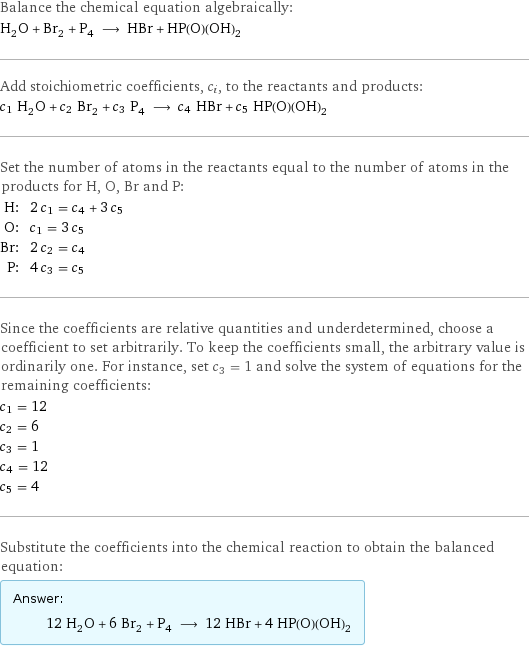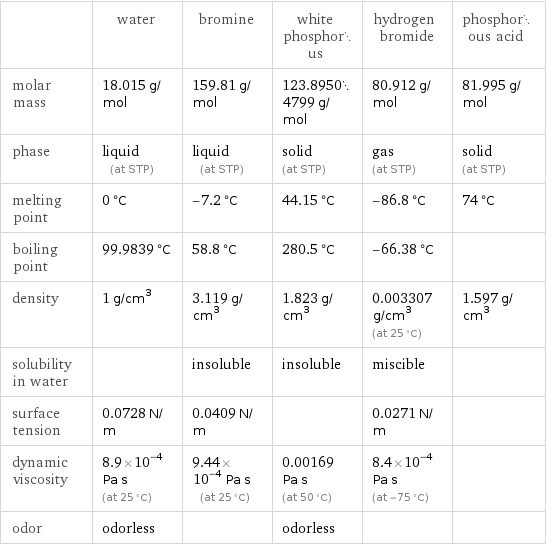Input interpretation

H_2O water + Br_2 bromine + P_4 white phosphorus ⟶ HBr hydrogen bromide + HP(O)(OH)_2 phosphorous acid
Balanced equation

Balance the chemical equation algebraically: H_2O + Br_2 + P_4 ⟶ HBr + HP(O)(OH)_2 Add stoichiometric coefficients, c_i, to the reactants and products: c_1 H_2O + c_2 Br_2 + c_3 P_4 ⟶ c_4 HBr + c_5 HP(O)(OH)_2 Set the number of atoms in the reactants equal to the number of atoms in the products for H, O, Br and P: H: | 2 c_1 = c_4 + 3 c_5 O: | c_1 = 3 c_5 Br: | 2 c_2 = c_4 P: | 4 c_3 = c_5 Since the coefficients are relative quantities and underdetermined, choose a coefficient to set arbitrarily. To keep the coefficients small, the arbitrary value is ordinarily one. For instance, set c_3 = 1 and solve the system of equations for the remaining coefficients: c_1 = 12 c_2 = 6 c_3 = 1 c_4 = 12 c_5 = 4 Substitute the coefficients into the chemical reaction to obtain the balanced equation: Answer: | | 12 H_2O + 6 Br_2 + P_4 ⟶ 12 HBr + 4 HP(O)(OH)_2
Structures

+ + ⟶ +
Names

water + bromine + white phosphorus ⟶ hydrogen bromide + phosphorous acid
Reaction thermodynamics
Enthalpy

| water | bromine | white phosphorus | hydrogen bromide | phosphorous acid molecular enthalpy | -285.8 kJ/mol | 0 kJ/mol | 0 kJ/mol | -36.3 kJ/mol | -964.4 kJ/mol total enthalpy | -3430 kJ/mol | 0 kJ/mol | 0 kJ/mol | -435.6 kJ/mol | -3858 kJ/mol | H_initial = -3430 kJ/mol | | | H_final = -4293 kJ/mol | ΔH_rxn^0 | -4293 kJ/mol - -3430 kJ/mol = -863.2 kJ/mol (exothermic) | | | |
Equilibrium constant
![Construct the equilibrium constant, K, expression for: H_2O + Br_2 + P_4 ⟶ HBr + HP(O)(OH)_2 Plan: • Balance the chemical equation. • Determine the stoichiometric numbers. • Assemble the activity expression for each chemical species. • Use the activity expressions to build the equilibrium constant expression. Write the balanced chemical equation: 12 H_2O + 6 Br_2 + P_4 ⟶ 12 HBr + 4 HP(O)(OH)_2 Assign stoichiometric numbers, ν_i, using the stoichiometric coefficients, c_i, from the balanced chemical equation in the following manner: ν_i = -c_i for reactants and ν_i = c_i for products: chemical species | c_i | ν_i H_2O | 12 | -12 Br_2 | 6 | -6 P_4 | 1 | -1 HBr | 12 | 12 HP(O)(OH)_2 | 4 | 4 Assemble the activity expressions accounting for the state of matter and ν_i: chemical species | c_i | ν_i | activity expression H_2O | 12 | -12 | ([H2O])^(-12) Br_2 | 6 | -6 | ([Br2])^(-6) P_4 | 1 | -1 | ([P4])^(-1) HBr | 12 | 12 | ([HBr])^12 HP(O)(OH)_2 | 4 | 4 | ([HP(O)(OH)2])^4 The equilibrium constant symbol in the concentration basis is: K_c Mulitply the activity expressions to arrive at the K_c expression: Answer: | | K_c = ([H2O])^(-12) ([Br2])^(-6) ([P4])^(-1) ([HBr])^12 ([HP(O)(OH)2])^4 = (([HBr])^12 ([HP(O)(OH)2])^4)/(([H2O])^12 ([Br2])^6 [P4])](../image_source/8506a3e571da255e54ca44caf6e6bfe7.png)
Construct the equilibrium constant, K, expression for: H_2O + Br_2 + P_4 ⟶ HBr + HP(O)(OH)_2 Plan: • Balance the chemical equation. • Determine the stoichiometric numbers. • Assemble the activity expression for each chemical species. • Use the activity expressions to build the equilibrium constant expression. Write the balanced chemical equation: 12 H_2O + 6 Br_2 + P_4 ⟶ 12 HBr + 4 HP(O)(OH)_2 Assign stoichiometric numbers, ν_i, using the stoichiometric coefficients, c_i, from the balanced chemical equation in the following manner: ν_i = -c_i for reactants and ν_i = c_i for products: chemical species | c_i | ν_i H_2O | 12 | -12 Br_2 | 6 | -6 P_4 | 1 | -1 HBr | 12 | 12 HP(O)(OH)_2 | 4 | 4 Assemble the activity expressions accounting for the state of matter and ν_i: chemical species | c_i | ν_i | activity expression H_2O | 12 | -12 | ([H2O])^(-12) Br_2 | 6 | -6 | ([Br2])^(-6) P_4 | 1 | -1 | ([P4])^(-1) HBr | 12 | 12 | ([HBr])^12 HP(O)(OH)_2 | 4 | 4 | ([HP(O)(OH)2])^4 The equilibrium constant symbol in the concentration basis is: K_c Mulitply the activity expressions to arrive at the K_c expression: Answer: | | K_c = ([H2O])^(-12) ([Br2])^(-6) ([P4])^(-1) ([HBr])^12 ([HP(O)(OH)2])^4 = (([HBr])^12 ([HP(O)(OH)2])^4)/(([H2O])^12 ([Br2])^6 [P4])
Rate of reaction
![Construct the rate of reaction expression for: H_2O + Br_2 + P_4 ⟶ HBr + HP(O)(OH)_2 Plan: • Balance the chemical equation. • Determine the stoichiometric numbers. • Assemble the rate term for each chemical species. • Write the rate of reaction expression. Write the balanced chemical equation: 12 H_2O + 6 Br_2 + P_4 ⟶ 12 HBr + 4 HP(O)(OH)_2 Assign stoichiometric numbers, ν_i, using the stoichiometric coefficients, c_i, from the balanced chemical equation in the following manner: ν_i = -c_i for reactants and ν_i = c_i for products: chemical species | c_i | ν_i H_2O | 12 | -12 Br_2 | 6 | -6 P_4 | 1 | -1 HBr | 12 | 12 HP(O)(OH)_2 | 4 | 4 The rate term for each chemical species, B_i, is 1/ν_i(Δ[B_i])/(Δt) where [B_i] is the amount concentration and t is time: chemical species | c_i | ν_i | rate term H_2O | 12 | -12 | -1/12 (Δ[H2O])/(Δt) Br_2 | 6 | -6 | -1/6 (Δ[Br2])/(Δt) P_4 | 1 | -1 | -(Δ[P4])/(Δt) HBr | 12 | 12 | 1/12 (Δ[HBr])/(Δt) HP(O)(OH)_2 | 4 | 4 | 1/4 (Δ[HP(O)(OH)2])/(Δt) (for infinitesimal rate of change, replace Δ with d) Set the rate terms equal to each other to arrive at the rate expression: Answer: | | rate = -1/12 (Δ[H2O])/(Δt) = -1/6 (Δ[Br2])/(Δt) = -(Δ[P4])/(Δt) = 1/12 (Δ[HBr])/(Δt) = 1/4 (Δ[HP(O)(OH)2])/(Δt) (assuming constant volume and no accumulation of intermediates or side products)](../image_source/d4e92bbcd59bf08f8e2a2fd9a8dff410.png)
Construct the rate of reaction expression for: H_2O + Br_2 + P_4 ⟶ HBr + HP(O)(OH)_2 Plan: • Balance the chemical equation. • Determine the stoichiometric numbers. • Assemble the rate term for each chemical species. • Write the rate of reaction expression. Write the balanced chemical equation: 12 H_2O + 6 Br_2 + P_4 ⟶ 12 HBr + 4 HP(O)(OH)_2 Assign stoichiometric numbers, ν_i, using the stoichiometric coefficients, c_i, from the balanced chemical equation in the following manner: ν_i = -c_i for reactants and ν_i = c_i for products: chemical species | c_i | ν_i H_2O | 12 | -12 Br_2 | 6 | -6 P_4 | 1 | -1 HBr | 12 | 12 HP(O)(OH)_2 | 4 | 4 The rate term for each chemical species, B_i, is 1/ν_i(Δ[B_i])/(Δt) where [B_i] is the amount concentration and t is time: chemical species | c_i | ν_i | rate term H_2O | 12 | -12 | -1/12 (Δ[H2O])/(Δt) Br_2 | 6 | -6 | -1/6 (Δ[Br2])/(Δt) P_4 | 1 | -1 | -(Δ[P4])/(Δt) HBr | 12 | 12 | 1/12 (Δ[HBr])/(Δt) HP(O)(OH)_2 | 4 | 4 | 1/4 (Δ[HP(O)(OH)2])/(Δt) (for infinitesimal rate of change, replace Δ with d) Set the rate terms equal to each other to arrive at the rate expression: Answer: | | rate = -1/12 (Δ[H2O])/(Δt) = -1/6 (Δ[Br2])/(Δt) = -(Δ[P4])/(Δt) = 1/12 (Δ[HBr])/(Δt) = 1/4 (Δ[HP(O)(OH)2])/(Δt) (assuming constant volume and no accumulation of intermediates or side products)
Chemical names and formulas

| water | bromine | white phosphorus | hydrogen bromide | phosphorous acid formula | H_2O | Br_2 | P_4 | HBr | HP(O)(OH)_2 Hill formula | H_2O | Br_2 | P_4 | BrH | H_3O_3P name | water | bromine | white phosphorus | hydrogen bromide | phosphorous acid IUPAC name | water | molecular bromine | tetraphosphorus | hydrogen bromide | phosphorous acid
Substance properties

| water | bromine | white phosphorus | hydrogen bromide | phosphorous acid molar mass | 18.015 g/mol | 159.81 g/mol | 123.89504799 g/mol | 80.912 g/mol | 81.995 g/mol phase | liquid (at STP) | liquid (at STP) | solid (at STP) | gas (at STP) | solid (at STP) melting point | 0 °C | -7.2 °C | 44.15 °C | -86.8 °C | 74 °C boiling point | 99.9839 °C | 58.8 °C | 280.5 °C | -66.38 °C | density | 1 g/cm^3 | 3.119 g/cm^3 | 1.823 g/cm^3 | 0.003307 g/cm^3 (at 25 °C) | 1.597 g/cm^3 solubility in water | | insoluble | insoluble | miscible | surface tension | 0.0728 N/m | 0.0409 N/m | | 0.0271 N/m | dynamic viscosity | 8.9×10^-4 Pa s (at 25 °C) | 9.44×10^-4 Pa s (at 25 °C) | 0.00169 Pa s (at 50 °C) | 8.4×10^-4 Pa s (at -75 °C) | odor | odorless | | odorless | |
Units
